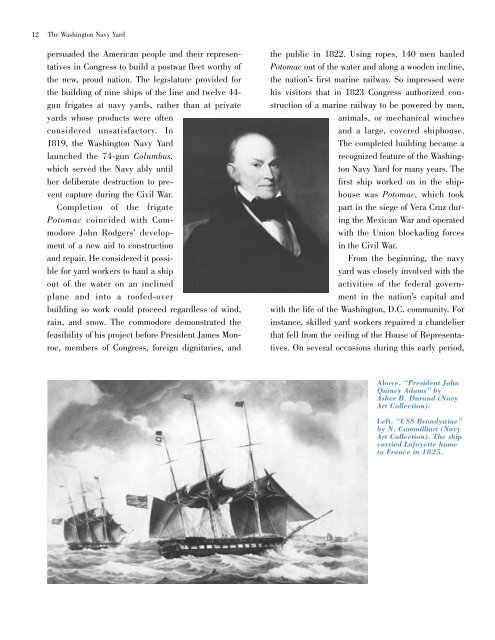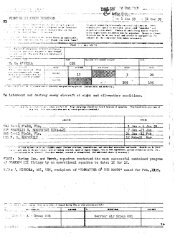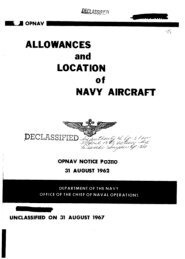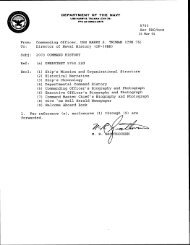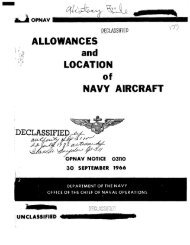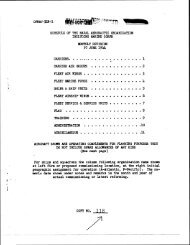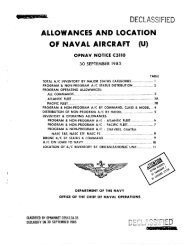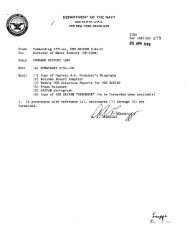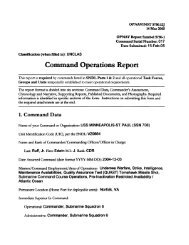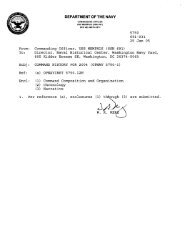the washington navy yard - Naval History and Heritage Command ...
the washington navy yard - Naval History and Heritage Command ...
the washington navy yard - Naval History and Heritage Command ...
Create successful ePaper yourself
Turn your PDF publications into a flip-book with our unique Google optimized e-Paper software.
12<br />
The Washington Navy Yard<br />
persuaded <strong>the</strong> American people <strong>and</strong> <strong>the</strong>ir representatives<br />
in Congress to build a postwar fleet worthy of<br />
<strong>the</strong> new, proud nation. The legislature provided for<br />
<strong>the</strong> building of nine ships of <strong>the</strong> line <strong>and</strong> twelve 44-<br />
gun frigates at <strong>navy</strong> <strong>yard</strong>s, ra<strong>the</strong>r than at private<br />
<strong>yard</strong>s whose products were often<br />
considered unsatisfactory. In<br />
1819, <strong>the</strong> Washington Navy Yard<br />
launched <strong>the</strong> 74-gun Columbus,<br />
which served <strong>the</strong> Navy ably until<br />
her deliberate destruction to prevent<br />
capture during <strong>the</strong> Civil War.<br />
Completion of <strong>the</strong> frigate<br />
Potomac coincided with Commodore<br />
John Rodgers’ development<br />
of a new aid to construction<br />
<strong>and</strong> repair. He considered it possible<br />
for <strong>yard</strong> workers to haul a ship<br />
out of <strong>the</strong> water on an inclined<br />
plane <strong>and</strong> into a roofed-over<br />
building so work could proceed regardless of wind,<br />
rain, <strong>and</strong> snow. The commodore demonstrated <strong>the</strong><br />
feasibility of his project before President James Monroe,<br />
members of Congress, foreign dignitaries, <strong>and</strong><br />
<strong>the</strong> public in 1822. Using ropes, 140 men hauled<br />
Potomac out of <strong>the</strong> water <strong>and</strong> along a wooden incline,<br />
<strong>the</strong> nation’s first marine railway. So impressed were<br />
his visitors that in 1823 Congress authorized construction<br />
of a marine railway to be powered by men,<br />
animals, or mechanical winches<br />
<strong>and</strong> a large, covered shiphouse.<br />
The completed building became a<br />
recognized feature of <strong>the</strong> Washington<br />
Navy Yard for many years. The<br />
first ship worked on in <strong>the</strong> shiphouse<br />
was Potomac, which took<br />
part in <strong>the</strong> siege of Vera Cruz during<br />
<strong>the</strong> Mexican War <strong>and</strong> operated<br />
with <strong>the</strong> Union blockading forces<br />
in <strong>the</strong> Civil War.<br />
From <strong>the</strong> beginning, <strong>the</strong> <strong>navy</strong><br />
<strong>yard</strong> was closely involved with <strong>the</strong><br />
activities of <strong>the</strong> federal government<br />
in <strong>the</strong> nation’s capital <strong>and</strong><br />
with <strong>the</strong> life of <strong>the</strong> Washington, D.C. community. For<br />
instance, skilled <strong>yard</strong> workers repaired a ch<strong>and</strong>elier<br />
that fell from <strong>the</strong> ceiling of <strong>the</strong> House of Representatives.<br />
On several occasions during this early period,<br />
Above. “President John<br />
Quincy Adams” by<br />
Asher B. Dur<strong>and</strong> (Navy<br />
Art Collection).<br />
Left. “USS Br<strong>and</strong>ywine”<br />
by N. Cammilliari (Navy<br />
Art Collection). The ship<br />
carried Lafayette home<br />
to France in 1825.


